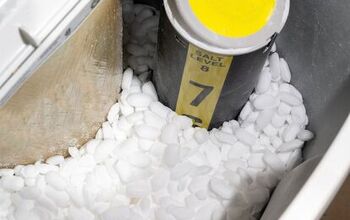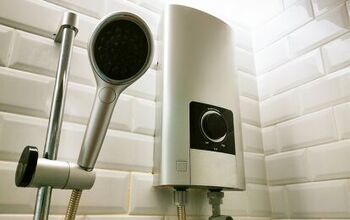GE Vs. Whirlpool Water Softener: What Are The Major Differences?

Depending on where you live, the hardness of the water can vary. Despite how it sounds, you can’t actually feel the water as being harder or softer. But there are various minerals within the water that make it “harder” at a lower level, which is felt by your clothes, skin, and more.
So, it only stands to reason that some people buy water softeners for areas where there is a greater presence of minerals. When it comes to GE and Whirlpool water softeners, which is the better option? Because the features are so different, it comes down to personal preference. GE’s water softener is better at customization and energy conservation. Whirlpool, meanwhile, has greater self-sense technology and tends to save space as well.
What Makes for a Good Water Softener?
Before we get into the different features of GE vs Whirlpool, let’s take a look at the various components behind a good water softener. There are a few things to consider. For one, the weight and dimensions matter for various reasons which we will cover.
Secondly, the flow rate is worth considering. The flow rate ultimately measures how much water usage the softener undertakes. Finally, think about the appliances that use water. The efficiency of the softener can help to extend the life of the appliances if it is doing its job properly.
Dimensions and Weight
For starters, take a look at the weight and dimensions of the softener you are considering. The size of the softener matters because it will last longer, likely have optimal pressure, control salt use, and ensure that you have consistently soft water.
When you pick a softener that is too small, it has to regenerate far more often. That means parts that are worn quicker and a softener that requires replacement sooner. Moreover, a smaller unit may not quite live up to the standards of water output.
Flow Rate
In most cases, the flow rate is directly related to the size of the water softener. The flow rate is what measures the water usage in a gallons per minute format. When you have multiple fixtures using an under-sized softener, it won’t get optimal flow rates.
Having lower flow rates means a couple of things. For one, it impacts the water pressure in your home. As the softening happens, water pressure will decrease significantly. When the flow rate decreases, you may be facing difficulties when it comes to softening the water, too.
Appliances in Use
Finally, you need to consider each of the appliances that use water in your home. The average home may have a coffee maker, dishwasher, several plumbing fixtures, a water heater, a washing machine, and more.
With consistently hard water, the life of those appliances are significantly shortened. A good water softener can help to expand the shelf life of those appliances substantially by preventing mineral buildup.
Considering GE Water Softeners
GE is an international conglomerate with billions in revenue each year. They have research and development, and production factories throughout the United States, China, Korea, and India to name a few.
That said, GE offers a wide variety of water softeners. They have five in total on their website. There is the GE 31,100 Grain Water Softener and Filter in One, the GE 30,400 Water Softener, GE 40,000 Water Softener, GE Smart 40,000 Water Softener, and the GE 45,100 Water Softener.
Prices for each of these models vary. You are looking at $399 to $799 when searching through GE’s website. You may, of course, be able to find them through a retailer for a little bit less.
Features of GE Water Softeners
The main focus of GE water softeners is about energy conservation. The main goal of the softener is to help remove minerals but depending on the brand, you could see a spike in energy use. That is why there is such an importance on energy conservation from GE’s offering.
The GE water softeners save on salt, energy, and water. They do so by using half of the amount of laundry and dishwashing detergent that would normally be required. Not only will you see a difference in the hardness of your water, you could save on your monthly allotment of detergents.
Customization and Ease of Use
GE’s water softeners are also quite big on customization. Some water softeners are fairly straight forward and really only run in one way. GE water softeners make use of blending valves, which gives users the ability to customize their soft water output.
Even better, GE’s water softeners are really easy to use. Pouring salt into the softer is simple thanks to an angled lid. Some of the others on the market may take greater effort to add salt to, but not the GE water softeners.
Self-Cleaning and Smart Technology
Furthering the ease of use is the self-cleaning functionality of the GE water softeners. The self-cleaning function protects the plumbing and appliances within the home using a self-cleaning sediment filter. That equates to longer-lasting appliances and pipes.
GE also makes use of their own SmartSoft technology. The softener has the ability to actually learn what the water use patterns are within the home and make adjustments accordingly. So, if users have no desire to make those changes, the softener will take the lead.
About Whirlpool Water Softeners
Just like GE, Whirlpool is a giant within the industry. They have been around over a century, initially launching as a machine company. Over those 100 years, they have grown as one of the leaders and most recognizable brands for home appliances.
Whirlpool also offers a number of water softeners. They have the Whirlpool 30,000 Grain Water Softener, Whirlpool 33,000 Grain Water Softener, Whirlpool 40,000 Grain Water Softener, Whirlpool 44,000 Grain Water Softener, and Whirlpool 48,000 Grain Water Softener.
The price range for Whirlpool’s line of water softeners vary quite a bit from GE. Their low-end water softeners are about $475, which is higher than the cheapest GE offering. That said, they top out at about $600, which is substantially cheaper ($799 for GE) than the competition.
Features of Whirlpool Water Softeners
Whirlpool, in contrast to GE, makes use of improved hardness removal. Sure, it uses more energy than its counterpart, but there may not be a better option on the market for hardness removal than Whirlpool’s line of softeners.
Whirlpool also puts a focus on practicality. There is an importance on the size of the water softener as well as how much salt that it requires. Though Whirlpool’s offerings may not be quite as energy-efficient as GE’s, it does help to reduce salt use as well as the amount of space taken up in the home.
Regeneration Cycles and 6th Sense Technology
Whirlpool softeners have demand-initiated regeneration cycles. That means that the regeneration process starts when the softener measures the water usage, preventing wasted water and salt.
In addition to the demand-initiated regeneration cycles, there is the Whirlpool patented 6th Sense technology. In tandem with the regeneration cycles, the 6th sense technology works to use less salt from the water softener’s brine tank. There is also a built-in low salt indicator that lets you know when you need to add more salt to the softener.
Saves Space and Retains Memory
The dimensions are certainly important for the overall quality of the water softener that you choose. But there are, of course, space limitations for most homes. The last thing that anyone wants is to purchase a softener only for it to not fit within space limitations.
Whirlpool makes use of a space-saving single tank design. This design ensures that the Whirlpool softeners are big enough to do the job without providing limitations on space.
Finally, there is the memory function. Whirlpool offers a memory retainer in the event of power outages. In areas where power outages are more common, it can be a hassle to reprogram the unit. Thankfully, the Whirlpool water softeners work to retain that memory even after the power has been cut. That saves a lot of hassle for users in certain areas.
Which is the Better Choice?
There really is no clear-cut winner between the two. Both sides offer distinctly different features that it can be hard to choose.
If you are looking for a greater removal of water hardness, Whirlpool is the clear choice. If flow rate is the most important feature to you, then the choice is GE. Really, both offerings are quite good, though not the best in class.
There are others on the market that may prove to be a superior alternative to these two major brands. That said, between the two, both provide solid offerings depending on what the consumer is looking for.
What is an Alternative Choice?
If neither GE nor Whirlpool really present the options that you like, Springwell may be worth considering. Their offering is much more expensive — $1,300 to $2,250 – but they are completely salt- and maintenance-free.
Without chemicals and maintenance, cleaning is easier than ever before. Moreover, appliances have a longer shelf life because the hardness is reduced and there is no salt required to do the job.
More Related Guides

Ryan Womeldorf has more than a decade of experience writing. He loves to blog about construction, plumbing, and other home topics. Ryan also loves hockey and a lifelong Buffalo sports fan.
More by Ryan Womeldorf



























